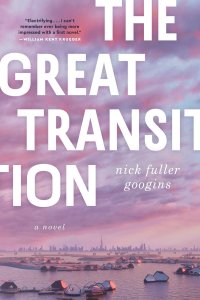Paul Di Filippo Reviews The Great Transition by Nick Fuller Googins
 The Great Transition, Nick Fuller Googins (Atria 978-1668010754, hardcover, 352pp, $27.99) August 2023
The Great Transition, Nick Fuller Googins (Atria 978-1668010754, hardcover, 352pp, $27.99) August 2023
This debut novel from Nick Fuller Googins, whose previous fictional outings have occurred in The Paris Review and other literary journals, is a cli-fi, hopepunk romp jampacked with ideas, energy, attitude, and action. Its themes are urgent and vital, and all the parts of its realtime future hang together cohesively and ingeniously. But before you can enjoy all its goodness, it does demand that you endorse a scenario that is pretty unlikely, if not impossible. And that scenario is this:
Our planet could accelerate from stressed environmental conditions more or less identical to those of 2023, through a total catastrophic eco-collapse that kills billions and devastates our infrastructure, and then could rebound to a kind of post-Tribulations high-tech pacifist utopia, all in the course of one human lifetime.
Yes, you read that correctly. Massive forest infernos, shattering of the ice shelves, big sea-level rises, retreat from the drowned old urban enclaves, the establishment of new sustainable cities in northern realms, hyperloop trains, new customs, polities and philosophies, all happening in the space of about seventy years. Actually, less than seventy years, because one of our main protagonists, Emi, is 15 years old and is accused of being a privileged “post-Crisis” kid who grew up in luxury—meaning that the space between her era of calmness and the beginning of the turbulence of the past is really about 55 years.
This is a future history that makes the 2004 flick The Day After Tomorrow look like sober-sided scientific conservatism.
Why does Googins insist on this timescale? For one reason only. To propel his entire plot, the villains of the Petroleum Age must still be alive as 90-year-olds. So do the math. Evil Oil Baron, utterly complicit in the Era of Climate Denial and Excess, is 90-something for Googins’ purposes. If they began their Evil Oil Baron Career at age 20, no more than 70-some years could have passed. And our heroine Emi testified that 15 of those years were the new balmy Renaissance of her childhood. Moreover, this telescoping of events allows Emi’s parents to have also lived first-hand through the chaos, accruing exciting life histories that figure prominently in the machinations of the present.
So: without belaboring any longer this huge barrier to suspension of disbelief, let me just reiterate that your enjoyment of what follows is going to hinge on your acceptance of such a compressed sequence of earth-shattering events.
And now, back to our feature presentation.
The new, planned city of Nuuk, Greenland, is home to Emi, her father Larch (these two figures alternate chapters from each POV), and Emi’s mother Kristina. Emi is busy being a student and a typically troubled teen (eating disorders mainly). Her father is the professional chef for the Tundra sports team. And Kristina continues shoring up the new world, as she has for her whole adult life, by extensive volunteering at such tasks as Extraction Duty. We get their family dynamics down nicely in those first few alternating-POV segments, while also being introduced to the contemporary culture. A big holiday—Day Zero—is on the horizon in Nuuk, but Kristina has to be out in the field—in old New York—and can’t share it with the others.
And so she is not there to experience what Larch and Emi undergo: a mass terrorist assassination event. On the bandstand of dignitaries are several ancient figures representing corporations and investors and politicians from the Bad Old Days. It seems they have paid their penance and been rehabilitated into society, still handling levers of power. But a group called the Furies resents their very existence, and has launched a new campaign to exterminate them.
And we soon learn that all signs point to Kristina being a key member of the Furies. Suddenly her frequent absences and fervent ideology shine in a new light.
But Larch and Emi need to hear this confession from Kristina herself, and so they set out for New York, pursued and tracked by agents of the Furies, agents of the targeted old order, and the legal authorities of the new state.
Filling at least half the narrative are flashbacks to the chaos that dominated the youth of Larch and Kristina, and the heroic, dangerous existences they lived. These passages solidify the reality of the realtime world (although, as stipulated, along unbelievably compressed dimensions) and offer some of the most stirring depictions of our planet’s future. Not surprising, since disasters and struggles are inherently more dramatic than the regulated, stabilized arcadia of Emi’s present.
That first spring of the Transition was the season they relocated the Statue of Liberty. Lucas and Osman and I wanted to see her while we could. We had just set boots on the ground with Maine Company and spent a demanding week deconstructing a row of Brooklyn brownstones. Our first day off the three of us hopped a ferry down the East River. Although the ferry turned out not to be a ferry but an architectural boat cruise packed with tourists—Saudis mostly—and the tour guide like a god directing our attention to which buildings would be spared and which would soon be home to harbor seals in the lobby. Other buildings she pointed out had already been deconstructed, leaving skyline gaps like missing teeth. We sailed under two bridges and around a bend and there she was. Rising from the water and cleaved almost perfectly at the torso.
Three cranes were lowering sections onto barges. Workers swarming all over her on scaffolding. Like sand fleas on a beached gull. Her top half was nothing but blue and cloud. Missing. Cut in two like Lucas and Osman and me and everyone. Probably the reason she was such a popular attraction then. I remember tourists pressing against the boat’s railing, livecasting the scene. Fighting for views. Same scramble people were doing for elephants and the Amazon and natural sand beaches: get it while you can.
But the danger and pursuit undergone by the family and the threat which the Furies pose to the established order also display their allure.
Eventually the family is reunited, and events take a surprising turn. Let’s just put it this way: Kristina offers no apologies for her campaign of targeted assassinations, claiming it’s a matter of justice, if not practicality. And Googins’ tone pretty much labels her view correct. So how does life go on from there?
With the least amount of stage time of the three, and no chapters narrated from her own POV, Kristina emerges as a fairly un-nuanced ideologue, a familiar martyr of the Revolution. The portraits of Larch and Emi are more granular. Larch reminds me of Delany’s character Bron, from Triton: a kind of big, shambling simplistic bear of a fellow, prone to emotional swings and a little hazy on his own motivations. Emi, I think, begs to be seen as the central figure of the whole tale, since it’s her future world that is being determined. She has an authentically quirky set of traits, including liking oldies music and backing off from intimacy. Her path of development shows the most progress and charm.
Dustjacket copy links this novel with the work of Kim Stanley Robinson, and I think that’s a fair assessment of intention and ability. Intent on depicting the intricacies of our immediate turbulent days ahead, and a possible brighter future, Googins has simply overstuffed his narrative out of passion and eagerness, rather than sloppiness and unthinkingness. The personal arcs of his centering family can almost swing the balance of credulity around.
 While you are here, please take a moment to support Locus with a one-time or recurring donation. We rely on reader donations to keep the magazine and site going, and would like to keep the site paywall free, but WE NEED YOUR FINANCIAL SUPPORT to continue quality coverage of the science fiction and fantasy field.
While you are here, please take a moment to support Locus with a one-time or recurring donation. We rely on reader donations to keep the magazine and site going, and would like to keep the site paywall free, but WE NEED YOUR FINANCIAL SUPPORT to continue quality coverage of the science fiction and fantasy field.
©Locus Magazine. Copyrighted material may not be republished without permission of LSFF.








Paul, i’m getting the book via my library…it currently has 12 holds, including me, on the Seattle Public Library’s 12 copies.